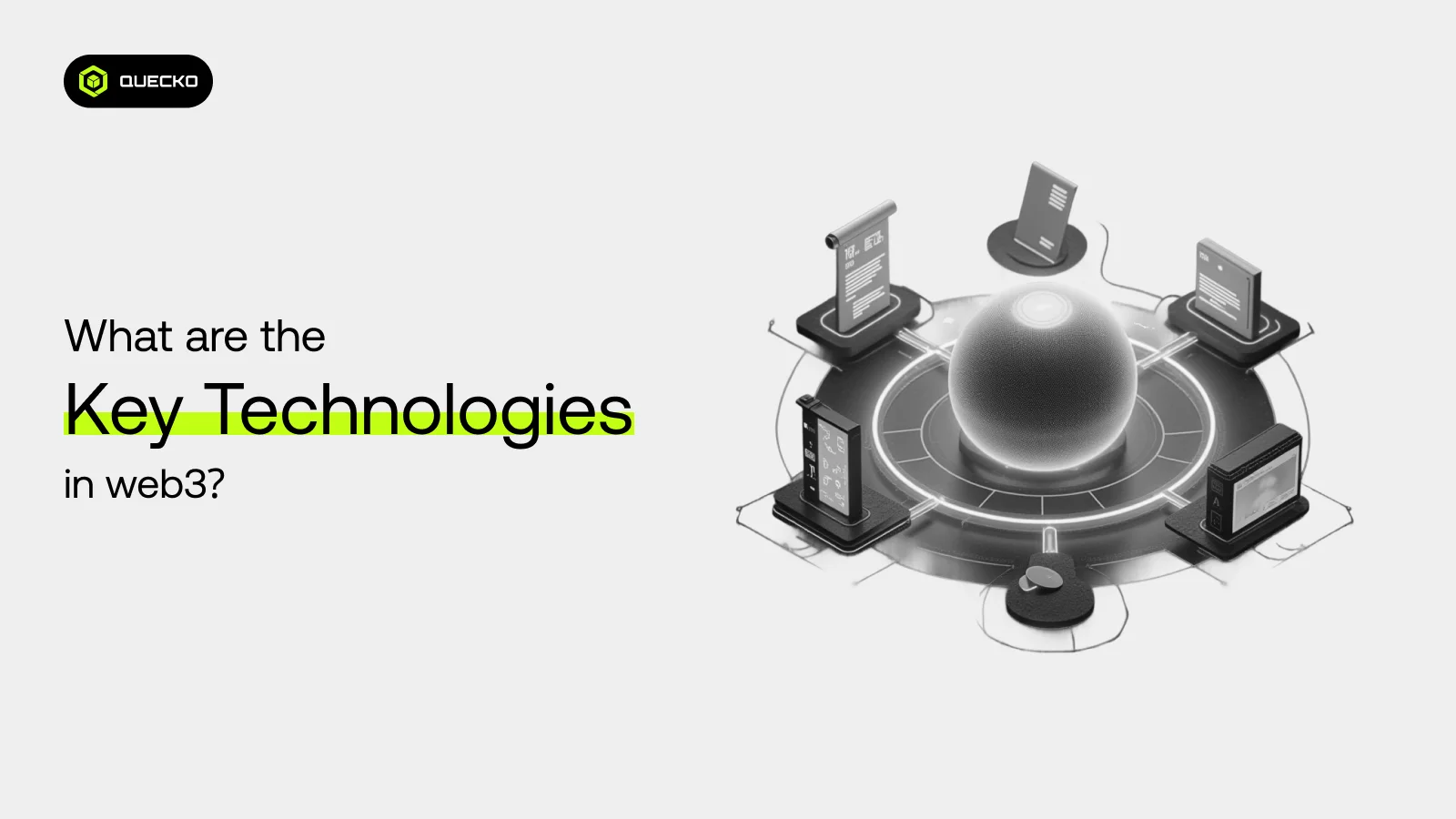What are the Key Technologies in Web3?
The digital landscape is shifting significantly, transitioning from the centralized Web2 model to the decentralized Web3 ecosystem. Web2, with its centralized control, often faces issues like data breaches, censorship, and lack of user privacy, Web3 technologies empower users with control over their data, identity, and interactions. This transformation is fueled by groundbreaking innovations like blockchain, […]

The digital landscape is shifting significantly, transitioning from the centralized Web2 model to the decentralized Web3 ecosystem. Web2, with its centralized control, often faces issues like data breaches, censorship, and lack of user privacy, Web3 technologies empower users with control over their data, identity, and interactions. This transformation is fueled by groundbreaking innovations like blockchain, DeFi, NFTs, and DAOs, which are redefining the future of the internet.
With the Web3 market projected to grow at a staggering 44.9% CAGR from USD 0.4 billion in 2023 to USD 5.5 billion by 2030, it’s clear that Web3 is not just a trend—it’s the next evolution of the internet.
This transition to Web3 is not just a trend it’s a pivotal moment in the history of the internet, fueled by several key technologies. These technologies are the foundation for a new era where control, transparency, and security are decentralized, empowering users to reshape their digital experiences. Let’s explore the core technologies driving the development of Web3 and how they will redefine the future of the Internet.
So, let us consider what are the key technologies driving the development of web3 and how they will change the essence of the digital world that we live in.
1. Blockchain Technology: The Backbone of Web3
Web3 is based on blockchain technology which is trustless and has a distributed architecture, thus the risk of a particular point failure is eliminated.Web2 often suffers from single points of failure and centralized control, leading to data breaches and censorship. It has also ensured that no form of censorship of information is practised since data storage does not have one dictator. It is self-evident that this will lead to the next phase of the internet revolution.
Additionally, it offers a trustless, distributed network where no single entity can control the flow of information. This decentralization mitigates the risks of censorship and failures associated with centralized systems, guaranteeing secure, transparent transactions.
Decentralized networks also present exciting opportunities for social media platforms. Unlike traditional centralized platforms, decentralized social media platforms empower users by ensuring freedom of expression, data ownership, and resistance to censorship. Transactions and interactions occur on blockchain-based protocols, preserving privacy and security while enhancing engagement.
Key Features of Blockchain in Web3:
- Decentralization: Information is distributed across a network of nodes, eliminating a single point of control. This ensures that no one entity has dominance over the system, making censorship impossible. Each node in the network of nodes plays a crucial role in maintaining decentralization, verifying transactions, and ensuring the integrity of the system.
- Immutability: Once data is added to the blockchain, it cannot be altered or erased, ensuring data integrity and fostering trust in digital interactions.
- Smart Contracts: These self-executing contracts automate processes by executing code when specific conditions are met. This eliminates intermediaries, reduces costs, and enables decentralized applications (dApps), ranging from decentralized finance (DeFi) platforms to NFT marketplaces.
- Tokenization: Blockchain enables the creation of digital assets like cryptocurrencies, NFTs, and tokenized physical assets. These tokens fuel the Web3 economy by enabling secure, peer-to-peer transactions and crowdfunding opportunities.
Example
Ethereum’s blockchain powers thousands of dApps, from DeFi platforms like Uniswap to NFT marketplaces like OpenSea.
2. Decentralized Networks and Protocols: The Framework for User Control
Decentralized networks are foundational to Web3, empowering peer-to-peer interactions without reliance on centralized servers. These networks distribute data and processes across multiple nodes, creating a robust, open ecosystem that prioritizes user autonomy, security, and transparency. Protocols like the InterPlanetary File System (IPFS) exemplify this decentralized approach by enabling distributed storage and data sharing, which enhances resilience, scalability, and resistance to censorship.
Key Features of Decentralized Networks in web3:
- Peer-to-Peer Architecture: Users interact directly with each other, bypassing centralized servers and enhancing security by reducing the risk of data theft or manipulation.
- Censorship Resistance: As there is no central point of control, decentralized networks cannot be shut down or censored, making them a vital tool for freedom of expression and enabling communication in difficult situations.
- Interoperability: Decentralized protocols are evolving to enable seamless communication and data sharing across different blockchains and applications. Solutions like Polkadot and Cosmos are enhancing cross-chain compatibility, creating a unified Web3 ecosystem.
Example
IPFS allows users to store and share files in a decentralized manner, making it nearly impossible to censor or shut down.
3. Cryptography: Ensuring Security and Privacy
Cryptography is the backbone of security in Web3, employing advanced mathematical techniques to safeguard data, communications, and transactions. It ensures that users can interact securely, privately, and verifiably in a decentralized environment. As one of the key technologies driving the development of Web3, cryptography eliminates the need for trust in intermediaries, enabling a secure, user-first ecosystem that underpins blockchain technology and Web3 applications.
Key Cryptographic Components in Web3:
- Public and private keys are fundamental to Web3 security. Public keys are shared openly to receive data, while private keys are used to authorize transactions and decrypt sensitive information. This ensures that only authorized parties have access to digital assets, maintaining the integrity and security of transactions.
- Digital signatures play a crucial role in confirming the authenticity of transactions. By using private keys, digital signatures provide an unalterable record, fostering trust in digital interactions. This cryptographic technique ensures that transactions are secure and verifiable.
- Encryption transforms readable data into a coded format, ensuring privacy and security. Web3 applications use encryption to protect sensitive communications and transactions, making it difficult for unauthorized parties to access or tamper with the data.
- Zero-knowledge proofs (ZKPs) allow one party to prove the validity of a statement without revealing any underlying data. This enhances privacy and security by enabling verification without disclosing sensitive details. ZKPs are particularly useful in scenarios where confidentiality is paramount.
- Hashing converts data into a fixed-length string, ensuring that even the smallest changes in data are detectable. Blockchains use hashing to secure transactions and maintain data integrity. This process ensures that data remains consistent and tamper-proof throughout its life cycle.
Example
Zcash uses ZKPs to enable private transactions on its blockchain.
4. Decentralized Autonomous Organizations (DAOs): Shaping Governance in Web3
Decentralized Autonomous Organizations (DAOs) represent a revolutionary way of organizing and governing communities, businesses, and projects. Built on blockchain technology, DAOs work through smart contracts, ensuring decisions and operations are automated, transparent, and decentralized. Recognized as a key technology driving the development of Web3, DAOs highlight the shift towards more democratic and user-driven governance models in the digital age.
Features of DAOs in web3
- Transparency: All decisions and transactions in DAOs are recorded on the blockchain, ensuring complete visibility and accountability.
- Decentralized Governance: Power is distributed among members rather than concentrated in a central authority. Token holders participate in voting on critical decisions, making the organization more democratic and responsive.
- Efficiency: By automating processes through smart contracts, DAOs reduce administrative overhead and improve operational speed. This enhances decision-making and reduces delays in execution.
Example
MakerDAO, a decentralized lending platform, allows token holders to vote on critical decisions like interest rates.
5. Decentralized Finance (DeFi): Disrupting Traditional Financial Systems
Decentralized Finance (DeFi) is revolutionizing the financial landscape by providing a decentralized, open-source alternative to traditional banking and financial systems. Built on blockchain networks, DeFi platforms eliminates intermediaries like banks, allowing users to take full control of their assets and participate in a borderless, permissionless financial ecosystem.
Key Features of web3 in DeFi:
- Lending and Borrowing: Platforms like Aave and Compound allow users to lend and borrow crypto assets, bypassing traditional banks and credit checks.
- Decentralized Exchanges (DEXs): DEXs like Uniswap allow peer-to-peer trading of digital assets, ensuring users retain control over their funds without relying on a central authority.
- Yield Farming and Staking: DeFi offers innovative ways to earn passive income through yield farming and staking, where users lock their assets in liquidity pools or participate in network validation to earn rewards.
Example
Uniswap, a decentralized exchange, allows users to trade cryptocurrencies without relying on a central authority.
6. Gaming and the Metaverse: Redefining Digital Interaction
Gaming and the metaverse are two emerging areas that leverage blockchain and decentralized technologies, becoming key components in the development of Web3. Using blockchain and decentralized technologies, these areas are key to building Web3. As key technologies driving the development of Web3, they’re paving the way for a decentralized, immersive digital future.
Players can earn cryptocurrencies or NFTs through gameplay, introducing new economic opportunities. These earnings can be traded, sold, or used within other blockchain-based platforms, creating real-world economic opportunities and incentivizing active participation.
Example
Games like TapSpace, Hamster Kombat, Axie Infinity and Gods Unchained enable players to monetize their gaming skills.
Web3 In Gaming
- Play-to-Earn (P2E): Web3 gaming enables players to earn cryptocurrencies or NFTs through gameplay, introducing new economic opportunities and incentivizing active participation.
- Interoperability: Blockchain technology allows players to transfer in-game assets across different platforms, creating a more seamless and expansive gaming experience.
- Player Ownership: Web3 gaming enables players to own in-game assets, such as characters and skins, as NFTs. These assets can be traded or sold, providing real-world value beyond the game.
Web3 In the Metaverse
- Virtual Real Estate: Users can buy, sell, and develop virtual land represented as NFTs. Platforms like Decentraland and The Sandbox allow users to monetize their virtual properties.
- Decentralized Social Spaces: The metaverse hosts decentralized environments where users can interact and socialize without centralized control, ensuring freedom of expression.
- Economic Systems: Cryptocurrencies and NFTs power the metaverse economy, allowing users to trade virtual goods, invest in digital assets, and create new business opportunities.
- Virtual Real Estate: The metaverse allows users to buy, sell, and develop virtual land, often represented as NFTs. This virtual real estate can be monetized through events, advertisements, or development into unique digital experiences.
- Decentralized Social Spaces: The metaverse hosts decentralized platforms where users can interact in immersive, virtual environments. These spaces are controlled by the community, not a centralized authority, ensuring freedom of expression and participation.
7. Non-Fungible Tokens (NFTs): Unlocking Digital Ownership
Non-fungible tokens (NFTs) are unique, indivisible digital assets verified on a blockchain. Unlike cryptocurrencies, which are fungible and interchangeable, NFTs represent ownership of distinct items, each with verifiable authenticity and provenance. This revolutionary technology has redefined ownership, enabling the secure transfer of digital and physical assets in a decentralized ecosystem. NFTs have unlocked unprecedented opportunities for creators, gamers, and businesses.
As a key technology driving the development of Web3, NFTs are unlocking unparalleled opportunities for creators, gamers, and businesses. Their growing adoption positions them as a vital component of Web3’s transformation, redefining how value and ownership are perceived in the digital age.Example: CryptoPunks, one of the first NFT projects, has seen individual NFTs sell for millions of dollars.
Role of NFTs in Web3:
NFTs are transforming the digital landscape by introducing new ways to own, create, and interact with digital assets.
Redefining Ownership
NFTs provide verifiable ownership of digital and physical assets, offering new opportunities for creators, gamers, and businesses. This unique ownership model ensures that each asset is one-of-a-kind and cannot be replicated. For artists, this means their digital art can be authenticated and sold as original pieces. Gamers can own in-game items, such as rare skins or characters, which can be traded or sold in secondary markets. Businesses can tokenize physical assets, like real estate or collectables, making them accessible to a global audience.
Creating Value
NFTs have introduced new revenue models, allowing artists and content creators to monetize their work while retaining ownership and control. By minting their creations as NFTs, artists can earn royalties on every subsequent sale, ensuring a continuous income stream. This model empowers creators to benefit from the increasing value of their work over time. Additionally, NFTs enable innovative crowdfunding opportunities, where supporters can invest in projects and receive unique digital assets in return.
Enhancing Interactivity
NFTs are not just static assets; they can be interactive and dynamic. For example, NFTs can represent virtual real estate in the metaverse, where owners can build and monetize their digital properties. In gaming, NFTs can evolve and gain new attributes based on player actions, creating a more engaging experience. This interactivity adds a new dimension to digital ownership, making NFTs more than just collectables.
Building Communities
NFTs foster vibrant communities around shared interests and passions. Collectors and creators can connect through NFT marketplaces and social platforms, forming networks that support and promote each other’s work. These communities often organize events, collaborations, and exclusive drops, enhancing the sense of belonging and engagement.
Driving Innovation:
The rise of NFTs is driving innovation across various industries. From fashion to music, brands are exploring how NFTs can create unique experiences and products. Musicians can release limited edition albums as NFTs, offering fans exclusive content and experiences. Fashion brands can launch digital clothing lines, allowing users to dress their avatars in the metaverse. This wave of innovation is expanding the possibilities of what NFTs can achieve.
Challenges and Limitations of Web3
While Web3 offers immense potential, it’s not without challenges:
- Scalability Issues: High gas fees on Ethereum can make transactions expensive.
- User Adoption Barriers: Managing private keys can be complex for non-tech-savvy users.
- Regulatory Uncertainties: Governments are still figuring out how to regulate decentralized technologies.
Solutions Web3 Provides
- Layer 2 Scaling: Solutions like Polygon reduce transaction costs and improve scalability.
- User-Friendly Wallets: Wallets like MetaMask are becoming more intuitive.
- Clearer Regulations: Industry leaders are working with regulators to create balanced frameworks.
Conclusion
During these revolutionary years, I see the integration of blockchain, cryptography, decentralized networks, gaming, metaverse, DeFi, DAOs, and several other areas like AI, ML and Cyber Security become clear that they are all key contributors in developing Web3. In essence, these will provide us with a safer, more customer-focused, and fairer internet.
Moreover, Web3 continues to take shape, these ideas will fundamentally change the nature of our interactions, the nature of our transactions, and how we build our digital lives. Such changes will provide users with exceptional power and freedom. It’s all these Web3 innovations that will help us traverse into a future which is liberating and filled with new possibilities. However, that transformation doesn’t come easy – are you willing to take the challenge and join in as a part of this transformation?
Date
11 months agoShare on
Related Blogs

Smart Contracts vs Traditional Contracts: What Businesses Need to Know
14 days ago

From Texts to Trust: How Blockchain Makes Messaging Safer
21 days ago

Bitcoin vs Gold: Is the Comparison Still True in 2025?
26 days ago

Oracles Explained: The Unsung Heroes of Smart Contracts
1 month ago







